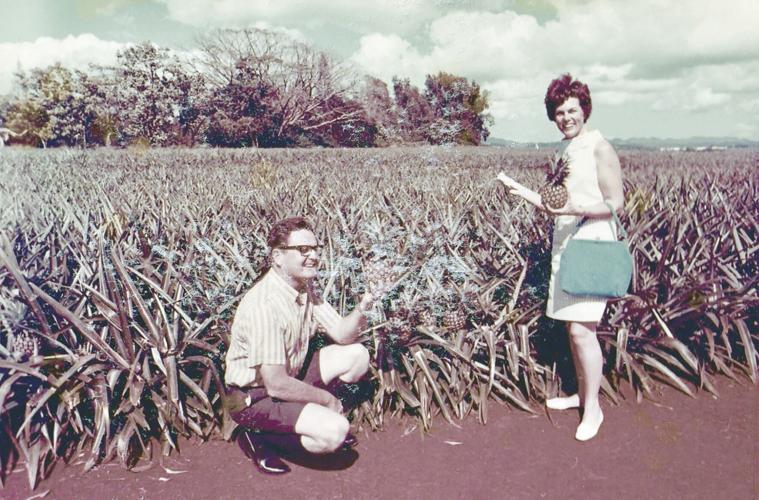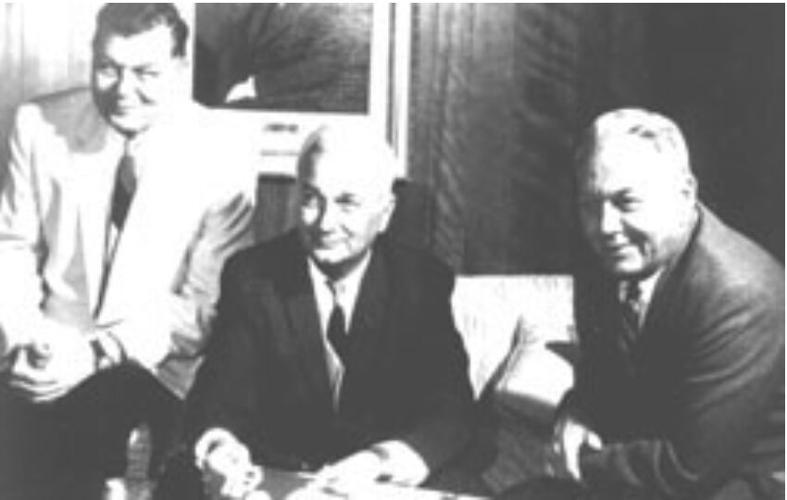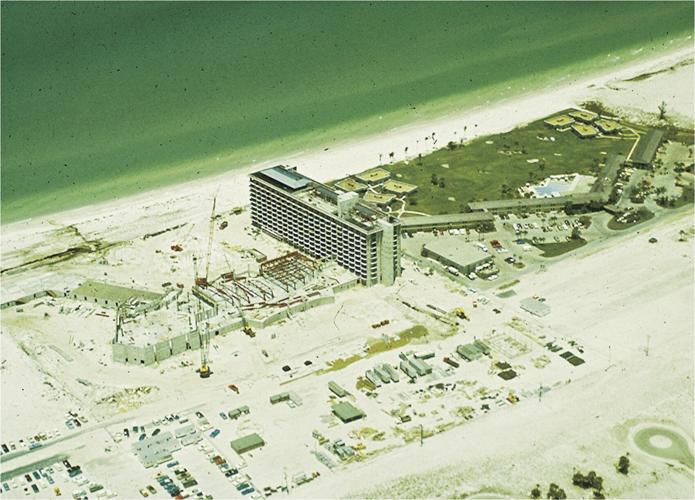The Deltona Corporation was a true example of America at its best. When Frank, Robert, and Elliott Mackle stood on the big crescent beach on Marco in 1962, they shared a vision almost as inspired and aggressive as the early years of NASA and the American space program that was launching from the other side of the peninsula. Like NASA, the Mackle brothers and the Deltona Corporation did not accept the words “no,” and “it can’t be done,” without the greatest difficulty.
If there was an obstacle…there was a way around it. Many said it was beyond impossible to build a complete infrastructure of roads, bridges, and utilities and to dredge and fill 24-square miles of mosquitoes and mangroves into 90 miles of navigable waterways. If these presented challenges to the Mackle brothers, well they simply rolled up their shirtsleeves and went to work.
Development on a large scale was nothing new to Deltona. The Mackle brothers had already successfully completed other communities in Florida and with America boldly striding forward into every venue from medicine to outer space, the time for creating the best coastal community in America was about to take place.
The Mackles were very different from typical land developers as their primary interest was not the financial bottom line. The Mackle brothers wanted to build something that was lasting. They wanted to build a way of life for future generations, and like many visionaries in the 1960s, Frank, Elliott, and Robert Mackle wanted to construct a vision and watch a dream come true.
When the early master plans for Marco were under construction, the Mackles announced that anyone who wanted a church could have land to build a house of worship. The Mackles also proclaimed that the center of the snow-white crescent beach was to be set aside in perpetuity for the residents of Marco Island. For every family and resident that lived on Marco there would always be a special beach just for islanders. The officers of the Deltona Corporation knew they had to make a profit, but they also knew there was a responsibility of ownership for the islanders of the future.
When it came time to showcase a modern and developing Marco Island, Deltona decided that the largest of the Ten Thousand Islands was too far south to compete with Florida. Marco was the last outpost before the Everglades - closer to Cuba than Orlando - and that any marketing strategy designed to compete with other developments in the Sunshine State would not be effective because the island was too remote. The marketing designers therefore decided the only subtropical zone in America other than Hawaii would compete with that tropical paradise and all new architectural designs on Marco were to be inspired by Polynesia.

Herb and Emily Savage in a pineapple field during their trip to Hawaii, searching for ideas on how to develop Marco Island.
The Golden Age of Development and the Marco Master Plan
Herb Savage was the principal architect for the Deltona Corporation and after the Mackles and the senior management decided that the “Master Plan” was to build an island paradise to rival Hawaii, Savage flew to the Hawaiian Islands and Tahiti to get a real feel for Polynesian architecture.
When Herb came back after a six-week tour of Hawaii and the South Seas, every building that came off his drawing board had a distinctive flair native to the islands. The new yacht club rising beside the newly constructed bridge would be one of the first structures anyone would see when coming over the Marco River. The new social center for boating would feature the South Seas tribal traditions of peaked ceilings and dramatic roof structure, along with coral stonework and the vibrant color schemes so prominent in the South Pacific.
The architectural crown jewel in the South Sea’s challenge was also to be the most exciting. Frank Mackle wanted a focal point and a showcase for his island and he wanted something extraordinary. In the final months of 1969, Deltona decided there must be an ultimate theme and focal point to the South Seas master plan and the Mackle brothers wanted to build a resort destination hotel to introduce Marco Island.
There was to be an airline to shuttle potential real estate clients from Tampa and Miami daily, and when the invited guests began to arrive, the Mackle brothers wanted the Marco experience to be like none other.

The Mackle Brothers.
Upon touchdown and landing on Marco Island, curious passengers would be welcomed at a small airport terminal. After only a short drive, the newly arrived guests were ushered past swaying coconut palms and a cascading fountain and into the tropical landscape surrounding the Marco Beach Hotel and Villas. When the guests arrived under the grand Polynesian peaks of Herb Savage’s South Seas architecture, a journey was complete and everyone knew they had just discovered the best-kept vacation secret in the United States. The breathtaking view overlooking the sparkling resort pools, the crescent beach, and the endless aquamarine of the Gulf of Mexico was inspirational enough to last a lifetime.
The Marco Brand of Modern Marketing
As with any resort destination, attention to detail is the deciding factor between a runaway success and another lesson in hindsight. For the newly opened Marco Beach Hotel, the attention to details and branding were beyond exceptional. A team of graphic artists arrived on the island to create the ultimate resort logo and island insignia. No expense was too great for the branding artwork to represent Marco Island, and after months of careful consideration, three naturally occurring colors and a circular crest was fashioned into a breaking ocean wave with the shape of an “m” for Marco. The inspired colors were the aquamarine from the gulf, the cream color of the sandy beach, and the vibrant green from the resort grounds and the neighboring golf courses.
The new tricolor wave for Marco was a runaway success and soon the branding logo and color scheme for the island began to appear on everything Deltona. The new Marco wave appeared on every cocktail glass, napkin, matchbook, and coffee cup. It was proudly shown on every golf cart, jeep, tractor, and every other island vehicle. The Marco tricolor was also aloft and highlighting the island theme with every takeoff and landing of Marco Island Airways at the international airports in Tampa and Miami. The breaking tricolor proudly swept into the lobby of the Marco Beach Hotel on the name tag of every Deltona associate and was prominent on the pens and pencils at Herb Savage’s “Quinn’s on the Beach.”
Island Architecture Becomes Notorious
With the Marco Island Yacht Club, the Country Club, and the Marco Beach Hotel sharing the same South Seas tropical theme, there was a thought that perhaps, the island’s only beachfront restaurant and bar should be well beyond anything existing in Florida - something literally - to write home about. If the Yacht Club, the Country Club and the Marco Beach projects were architectural exercises in casual elegance, then Herb Savage wanted his beachside bistro to take the island theme to a new level and become notorious.
When Deltona’s architect was exploring the Pacific, he discovered an unforgettable beachside bar in Tahiti where the food, the drinks, and the parties never stopped. Quinn’s Tahitian hut was the most infamous cabaret in all of the South Seas. Located in the Tahitian capital of Papeete, the waterfront bar was originally opened in 1933 by San Franciscan Robert Quinn as an ice cream parlor. Throughout the depression-era years and into the Japanese expansion of the South Pacific during the Second World War, Quinn’s changed dramatically as did the demands of an international clientele facing an uncertain wartime future. Every night at Quinn’s was like the last night on earth and as a result the charcoal grilled seafood, the exotic drinks, and the beautiful barmaids like the unforgettable Susie-no-pants reigned supreme.
There was a natural and sultry perfume in Quinn’s from the woven flower arrangements worn by the native girls and from the raw sandalwood drifting down from the hanging Polynesian canoes and the bamboo rafters. The flooring in Quinn’s was made from a shipwrecked Chinese Junk and sanded smooth by beach sand and the dancing feet of ten thousand celebrations.
After only one night at Quinn’s in Tahiti, Herb Savage knew that the South Seas theme for Marco Island would not be complete without a beachside rendition of the most notorious bar in the South Pacific. Quinn’s hut in Tahiti closed in 1973, but to this day, Quinn’s on the Beach at the JW Marriott continues to enjoy the status as one of the most successful and popular beachside bistros worldwide.
A Rising Star Begins to Shine
As the Deltona master plan continued, the Mackle brothers began to invite famous dignitaries to introduce the island. There can be no greater impact and validation of a resort destination than when visiting guests recognize iconic celebrities enjoying the same experience at the same resort.
Tony Lema won the British Open in 1964 and shortly afterward, the Mackles invited him to become the island golf pro and PGA professional for Marco Island. The Marco Beach Hotel and Golf Course was to be the new home for the rising golf star when he was not traveling the world and competing in tournaments. When the gregarious “Champagne Tony” was home on Marco, the golf celebrity with the bubbling moniker began to invite everyone that was anyone down to play golf and enjoy the fabulous fishing, the sensational sailing, and the casual elegance of Marco Island at the Marco Beach Hotel.
The Tony Lema Golf Tournament began in 1967, and soon celebrity icons like Bob Hope, Richard Nixon, and NASA astronauts Jim Lovell and Jack Swigert were all swinging the clubs at Marco Island Country Club and relaxing at Quinn’s on the Beach for the unforgettable sunsets. Baseball great Joe Garagiola and the Reverend Billy Graham were also island favorites along with Lee Trevino and Joe Namath. Arnold Palmer arrived in his own plane to try out the golf along with Jack Nicklaus and other PGA professionals too numerous to mention.
Lynne Topping was the unforgettable and highly visible pool manager at the Marco Beach Hotel and was Miss Florida during the height of the Deltona celebrity invitational. It was not unusual to be sitting poolside and ordering an exotic drink from Quinn’s and notice Victoria Principal climbing out of the water in a bikini as James Garner - the Hollywood film and television star - signed autographs at a hotel fashion show.
Captain Jim Martin was the beach and recreation manager for Deltona’s signature destination and modeled the resort activities after his experience as an officer on Norwegian Cruise Lines. The dashing and beautiful figures that worked at the resort were easily as well spoken and impressive as the celebrities that came to visit the island. As the budding community continued to flourish - with everyone that worked on the island living in the newly built homes - a new island lifestyle began as the magical essence of Marco once again began to cast her charm.

Building the Marco Beach Hotel and Villas, now the JW Marco Marriott.
Marriott Polishes the Crowned Jewel
When Marriott came to Marco in 1979, everything changed. The beachside invitational hotel so beautifully created by the Mackle brothers was obviously a sparkling jewel, but J.W. and Bill Marriott were also visionaries and they saw the potential for a resort hotel that would not only rival Hawaii but any other destination worldwide.
The branding, the attention to detail, and the quality of service were all standards held high by the islander staff working at the resort, but Marriott wanted to do what Marriott does best and go onward to the next level. Marriott quite simply wanted to raise the bar on every standard of excellence but the Marriott family was different from Deltona.
When Marriott came and began managing the resort, everyone was surprised. The very strict and formal school of business that was the standard of the day suddenly disappeared. The dark and prescribed business suits of the hotel managers were at once replaced with golf shirts and shorts. Marriott even had the audacity to install a young woman as resident manager. Al Edney was the new Marriott general manager at the Marco resort, but he could often be found loading beach towels into a washing machine in housekeeping, as Charlene Nagel, his second in command, straightened pool chairs and adjusted umbrellas as she socialized with visiting guests.
In a rising crescendo of new standards, Marriott began to enhance the resort. The north tower of oversized rooms was completed in 1983 - doubling the accommodation of the resort - along with expanded ballrooms, a new lobby mezzanine, and resort gift shops. Every five years there was a multi-million-dollar renovation either to renovate the rooms or to polish the property to even higher plateaus of excellence.
Beginning in 2015, and finishing in 2017, Marriott’s Marco Island Beach Resort became the JW Marriott and underwent the most expensive and expansive renovation in Marriott history to date. The entire section of ballrooms was recreated with an exciting new convention facility and a new section of resort suites that now rival any destination worldwide. Two Polynesian sailing catamarans by award winning British yacht designer, James Wharram, are now the signature Marriott excursion for exploring the wildlife and seashells of the neighboring islands.
In March of 2013, USA Today ranked the top ten islands in the United States. Marco Island was number three out of ten. During the same month, National Geographic Explorer listed the top 100 places in the world that could change your child’s life. Marco Island was the only destination listed in Florida. In March of 2014, Trip Advisor announced that Marco Island was now the number one island destination in the United States and ranked the big crescent strand on Marco as one of the most beautiful beaches in the world.
The ultimate vision of the Mackle brothers and the Deltona Corporation thrives today with the Marriott family as the modern-day innkeepers and hosts for a new generation of adventure seekers from across the globe. The vision of the Mackle brothers has been taken to a new level as the JW Marriott on Marco Island has emerged as not only one of the top ten vacation destinations in the nation but as a signature Polynesian-style resort that is truly a global contender.




Post a comment as Guest
Report
Watch this discussion.
(0) comments
Welcome to the discussion.
Log In
Keep it Clean. Please avoid obscene, vulgar, lewd, racist or sexually-oriented language.
PLEASE TURN OFF YOUR CAPS LOCK.
Don't Threaten. Threats of harming another person will not be tolerated.
Be Truthful. Don't knowingly lie about anyone or anything.
Be Nice. No racism, sexism or any sort of -ism that is degrading to another person.
Be Proactive. Use the 'Report' link on each comment to let us know of abusive posts.
Share with Us. We'd love to hear eyewitness accounts, the history behind an article.